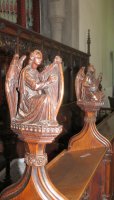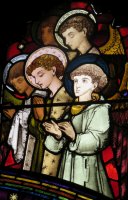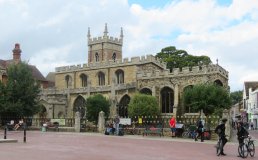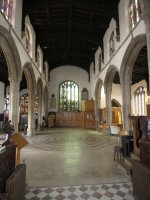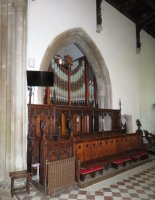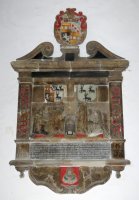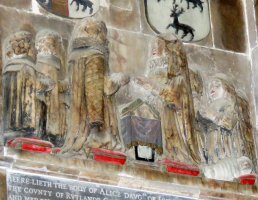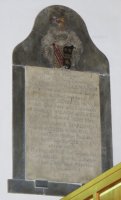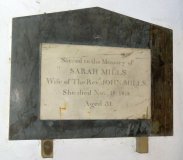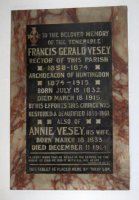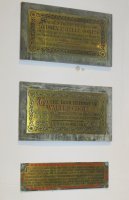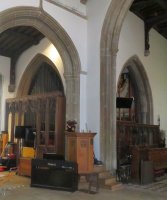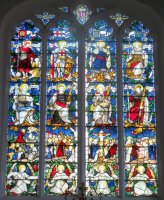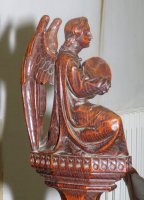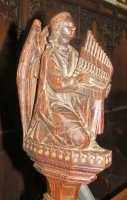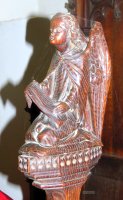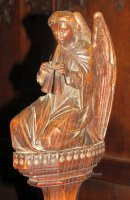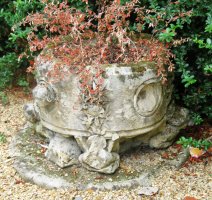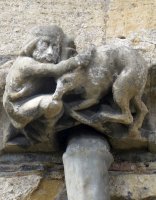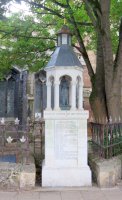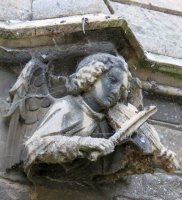All Saints Church Huntingdon - Monuments
All Saints Church, the more centrally placed of the two surviving ancient churches in Huntingdon, contains a modest selection of wall monuments. It has a good collection of carved wooden figurines as part of the choir stalls and the altar, and houses the font where Oliver Cromwell was baptised.
All Saints Church, Huntingdon, is in the natural centre of the town, forming one side of the central Market Square square on the High Street, and is suitably picturesque, being of varied outline and with lines of battlements along nave, chancel, aisles and tower, and on the porch. It is built primarily of pale sandstone rubble [irregular pieces], with the dressings of a hard, fossiliferous white limestone. The tower includes some red brick, and the view from Market Square has it to the rear, and rather short looking, with the crocketed pinnacles at the corners being the most distinctive feature. Mostly, what we see from the outside is from the 15th Century, with the brick part of the tower being perhaps 17th Century, and the battlements presumably being from a mid-19th Century refurbishment; there are some slight Norman remains..
All Saints, interior views.
The interior is broad, largely symmetrical, and light, due to the clerestory, and the pale floor and white walls, contrasting dramatically with the dark ceiling. There is one significant monument, a 17th Century kneeler monument, and several minor panels:
Monuments
- Alice [Greene] Weaver, d.1636, 'who in a jorney from London sickned & died at Huntingdon'.
A kneeler monument of fairly modest dimensions. The main elements exemplify such monuments:
the husband and wife face each other across a prayer desk, or faldstool, hands raised in prayer.
They wear rather shapeless garments, and grand ruffs, and kneel on tasselled cushions, by custom painted and repainted red.
The male offspring - two sons in this case, kneel behind the father, the daughters behind the mother, with the youngest,
a swaddled babe, lying on a cushion in front of the others. To keep the married couple in the centre of the piece,
there is less room for the daughters, so they are more cramped together than the sons.
The coats of arms of the parents are, here, above the figures. The kneelers, as is generally the case,
are under a canopy held up by pilasters [flattened pillars] to the sides, here decorated with carved ribbons,
with an hourglass above crossed arrows on one side, and a book with crossed, upturned torches below - the hourglass
and upturned torches are symbols of time passing and the snuffing out of life respectively. There is a heavy shelf above.
There are different choices what to do at the top, and the central painted shield of arms, quite large and within a cartouche,
is fairly usual, with the swan-necked [i.e. curly] broken pediment rather less so for this type of monument.
Under figures is the inscription, which, typically as here, is capitalised on a black backing; beneath that a shelf,
with a central descending portion (the apron) bearing in this case a painted shield, with crossed branches,
and with carved brackets to either side. So all this encapsulated in the one monument. Less usual is the masonry background,
and, really rare, that the husband wears his outer garment as a cloak with empty sleeve hanging down. Lots more about kneeler
monuments in general on this page.
The other monuments:
- Sir Lionell Walden, Knight and his wife Dame Elizabeth [Balaam] Walden,
and her sister Catharine Harding, d.1749, who ordered the panel to be erected. The inscribed panel
is surrounded by a dark border in separate parts, curved up at the to pto enclose a large, carved and painted shield of arms
with much mantling. With little black block supports at the base of the inscribed panel, placed on the backing rather than under it,
in what is likely a mistake during some refurbishment; a previous cut bracket can be seen in the lower frame.
Walden and Fullwood panels.
- The Fullwood Family, with a lengthy inscription back to Gerald Fullwood, d.1677,
through to Elizabeth Fullwood, d.1756, who ordered the tablet to be erected. The tablet is plain,
but the inscription worth reading, including for example noting William Fullwood, d.1685, Mayor,
'in respect of the said Dr Fullwoods being very helpfulll & Chartitable to ye Poor of this Burough in prescribing &
administering Physic for them gratis in time of their Sickness', with an asterisked note at the end of the panel that
'NB By Sickness is here meant the PLAGUE'. At the top is a nicely carved scrolly cartouche inclosing the painted arms of the family.
Sarah Mills, d.1818.
- Sarah Mills, d.1818, a modest white-on-black panel, with the backing being cut with a pediment shape on top; in front of this on top of the white inscribed panel must have been some small device, perhaps a pot, which has been pulled off. On two block supports.
- Francis Gerald Vesey, d.1915, Rector and later Archdeacon of Huntingdon,
and his wife Annie Vesey, d.1914, erected by their son. Plain panel, but with a surround of pinky brown alabaster
much favoured by the Arts and Crafts artists, and in use till this time.
Francis Vesey, Rector, d.1915.
- In addition there are several revival brass panels. Such things were produced from Victorian times through till the early 20th Century, and typically consist of a brass panel, with writing in black capitals or blackletter, often with the initials picked out in red, and some sort of repeating border relying for artistic effect on the contrast of black and red with the gleaming brass. They can be set on some backing panel, or more usually simply attached to the wall. Those in All Saints Church show typical variations on the type, for example : Walter Coote, d.1890, erected by his wife and children, with the border of a stylised, wavy vine with flowers at the corners, on a marble backing panel. Such pieces are often signed by the maker, and this one is by T. Pratt & Sons, Tavistock Street, London. Sydney Estelle Jones, d.1903, a child, is in the same style - see picture below (you will need to click to enlarge). And William Goodliff, Ernest Slade, and Arthur Enry-Jeffs, lost in the South African War [Boer War], 1899-1902. A variation on the theme.
- The Cromwell family tomb, closed in a 1950 restoration of the Church, is noted on a small panel on the floor, by the pulpit.
- Another brass panel records the Victorian alternation to the Church, including the rebuilding of the south aisle chiefly at the expense of David Veasey, with George Gilbert Scott as architect, John Bird as Builder (it is the lowest panel in the picture above). In this case the border is of red flowers, with screws at the corner, perhaps replacing some lost bosses.
Alice Weaver, d.1636, kneeler monument.
Also in the Church:
- The font, significant as being that in which Cromwell was baptised. 13th Century, but wrapped in a woolly font warmer, rare in itself, so that we cannot see the exterior: what is visible is the circular lead-lined bowl, with octagonal exterior.
- The roof is held on beams supported on brackets, with stone half-angels supporting the brackets, and small figures of saints, in wood presumably, standing upon them. The figures are named on scrolls held by the angels. We see Elijah with hairy coat, Daniel with a lion head and paws, St John Baptist and so forth. Note also a capital of a saint fishing from a boat (in the vestry), and a capital with a carving of a man holding a trowel, apparently building a wall.
- The altarpiece is in Gothic style, with tall niches occupied by wooden statuettes of saints, three to each side of the central figure of Christ. See picture at top of page (click to enlarge).
- The wooden pulpit, hexagonal with steps, given in 1950 by Alderman William Henry Clayton, four times Mayor of the borough.
- More wood in a screen in front of the organ, with tracery.
- A World War I panel, listing the fallen, with a rectangular frame of white stone, repeating leafy patterns round the edges, shield a the top, and stylised floral decoration.
Saints in Victorian stained glass.
- Some stained glass, some in a late Victorian style, a little sweet for modern taste but well executed and with nicely glowing colours. They are listed out in information in the Church, and include panels by Kempe, by Heaton, Butler and Bayne, and by Clayton and Bell and a pupil of theirs, W.F. Dixon.
- In the vestry, a nice roof boss of vine leaves and grapes, with a small boat in the centre with two small figures.
Several of choir stall angels.
- The best woodwork is the group of figures in the choir stalls, consisting of well carved angels with a variety of musical instruments, including a keyboard musical instrument, a harp, mandolin and some pan pipes, presumably to make any pagans feel at home in the Church. Not entirely serious about this last, but more to note that here, as in so many churches, there are elements of non-Christian symbolism.
Cromwell's place of baptism, and his family's burial.
Outside:
Given the town centre location, the Churchyard has largely gone, and what is left is a little patch of green to the side of the Church facing the Market Square, and a small, shaded, gravelled area to the other side.
The Market Square side has little figures of saints in niches, likely 19th Century, and the odd little carving, notably a crouched figure holding a stag by the horns. A few 19th Century tombstones lean against a wall, and there is a round plant holder with decayed cherub heads to the sides, and flowers, and below, ruined half figures, perhaps of angels. I wonder if this is the upper portion of a 19th Century font.
The darker, rear side is interesting. We see a row of four corbel half-angels, with cymbals, a violin, some other instrument, perhaps keyed, and a horn, and a little door with two heads as corbels. Presumably Victorian, but in the style of the late 18th Century. Other carving survives higher up, more ruined half angels, and what looks like a hare but seemingly hooves, thus a deer, and a goat, spirited carving. A rather nice tomb chest survives in place, with curved ends, and several older tombstones, likely late 18th Century, with relief carving – there are many more in the churchyard of St Mary's Church down the road.
Boer War memorial, Angel with stag.
There is also, against the railings, a Boer War memorial to the Huntingdonshire men from various regiments. It takes the form of a raised plinth with the inscriptions, supporting a hexagonal sided enclosure with a small figure within it of a knight in plate armour with a shield (see picture above, and at top of page) – he is St George, after Donatello, and the sculptor was Guglielmo Tosi, an Italian sculptor based in Brompton who did some carving for the architect Sir Charles Nicholson, including the figures of Christ, the Virgin and St John for the crucifix and rood in Wells Cathedral, and a reredos for St Nicholas Church, Stevenage; in his own stamping ground his also is the wooden Crucified Christ (i.e. Calvary) outside St Cuthbert, Philbeach Gardens, Earls Court. Above the statue is a metal roof and lantern. Very neat.
The Church website is at: https://www.huntingdonparish.org/our-churches
Also noted on these pages in Huntingdon: St Mary's Church monuments, and the Market Hill war memorial and other things of interest on this page.
